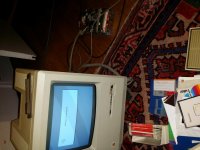raoulduke
Experienced Member
The keyboard doesn't seem to work at all, but my Mac Plus keyboard works fine on the Macintosh. The TI SN74LS123N chip's pins seem blackened, so my I'm going to replace that next - I've cleaned the traces on the bottom with isopropyl and reseated that chip and the Intel 8021 chip to no effect. *I forgot to mention that I also resoldered the four pins on the interface, also to no effect.
I cleaned the external floppy and mostly unstuck it. When I turn it on it can adjust the head distance properly (i.e. when I push it toward the back, the screw will turn and pull it in). Then it seems to flip the plastic the head is on up repeatedly while a red light is on and it makes a repetitive sound I'm failing to describe. Is this a symptom of something just being stuck? Putting a disk in doesn't help.
I cleaned the external floppy and mostly unstuck it. When I turn it on it can adjust the head distance properly (i.e. when I push it toward the back, the screw will turn and pull it in). Then it seems to flip the plastic the head is on up repeatedly while a red light is on and it makes a repetitive sound I'm failing to describe. Is this a symptom of something just being stuck? Putting a disk in doesn't help.

